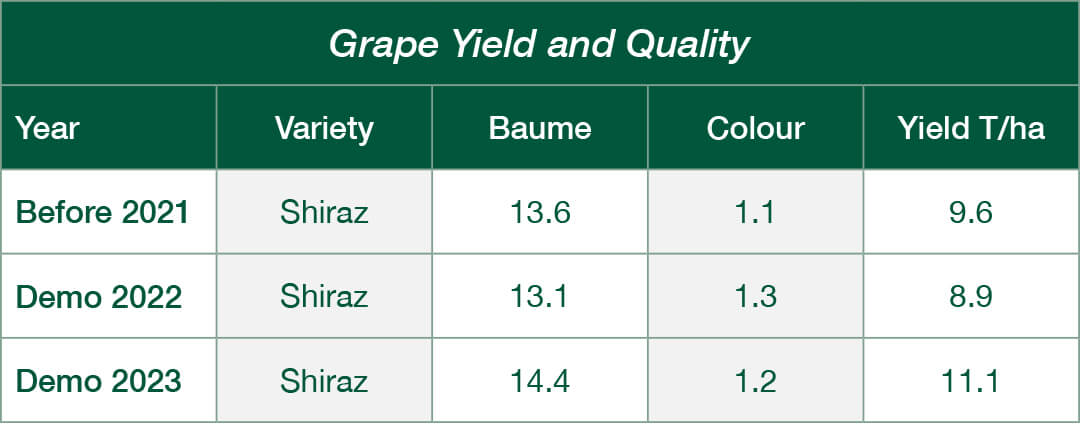
Latest
News
Impactful results even in challenging seasons
Organic Wine Grapes
In BioAg’s Winter/Spring Newsletter 2022, we wrote about a leading Australian wine producer seeking ways to improve the yield and quality of their organically grown grape crop. BioAg readily accepted this opportunity/challenge and has been working with the producer in their Riverina vineyards over the last 3 years. We are now pleased to provide the results and analysis undertaken on the Demonstration site.
A 12ha demonstration block of organic Shiraz vines was allocated for the Demonstration project, undertaken from May 2021 until March 2023 (harvest seasons 2022 and 2023). Soil tests were performed at the end of each harvest season to determine benchmarks for the seasons ahead.
BioAg designed a nutrition program based on soil tests results; the producer’s objectives to improve quality and yield; and consideration of historical issues at the site.
The objective at the start of the program was to maintain adequate to good levels of Phosphorus (P), Calcium (Ca) and Sulphur (S) levels, and to decrease Magnesium (Mg) and Sodium (Na) levels. The nutrition program utilised our natural solid fertiliser BioAgPhos® with an ameliorant (gypsum) to improve soil macronutrient levels and soil physical properties. BioAgPhos has P 12.3%, Ca 35% and S 1% and releases around one-third of those nutrients immediately, with the remainder released over 1 to 2 years.
In addition, soil testing identified key trace elements Manganese (Mn), Zinc (Zn), and Boron (B) as being moderate to low and were these were incorporated into – the nutrition program.
Micronutrients were applied in combination with BioAg biostimulants at key growth stages. These biostimulants provide important nutrients and metabolites specific to the stage of growth and are natural chelators of highly affordable micronutrient salts, aiding their adsorption and reducing losses to antagonists.
Soil inoculants and run-off from foliar applications also feed soil biology; increasing the numbers and diversity of beneficial soil micro-organisms; improving key properties related to soil biology (Soil & Seed® and HydraHume®); stimulating early vine vegetative growth (Balance & Grow®) and improving fruit set and development (Fruit & Balance®). Early season improvement in soil biology stimulates root growth and improves nutrient cycling and availability by creating organic complexes that aid nutrient absorption.
Results
The 2021 to 2023 seasons were colder and wetter than normal/ average seasons, hindering growth across all the producer’s operations (conventional and organic). While the nutrition program ensured vines had access to all critical nutrients, the climatic conditions impacted both the yield and quality of the grapes.
Yields of around 10T/ha in organic production are considered ‘good’. The impact of weather conditions was also evident in the yield results at a conventional block of the same Shiraz variety which were below 10T/ha in 2022 (target yield for conventional systems is in the range of 18 to 22T/ha).
Despite the wet and cool conditions, the producer noticed a significant improvement in crop growth throughout the season compared to prior years. There was clear benefit from the post-harvest solid fertiliser applications which supported vine recovery and nutrient uptake prior to dormancy. This in turn supported early season vigour, with important growth stages supported with foliar applications.
The weather conditions induced a higher risk and increased occurrence of Downy Mildew and Botrytis across the entire vineyard. However, the BioAg demonstration block suffered fewer incidents of disease compared to all other blocks, including the chemically treated conventional blocks. This was achieved by supporting early growth and key growth stages, ensuring the vines were stronger and healthier and therefore better able to combat disease and stress themselves, without the need for additional chemical treatments.
The demonstration has shown the Vineyard Manager the benefit of balanced nutrition programs and the use of biostimulants to support crop physiology and nutrient cycling and uptake, and how biostimulants aid in the use of lower cost inputs. The outcome is they are now incorporating the program into several conventional blocks.



Recent Comments